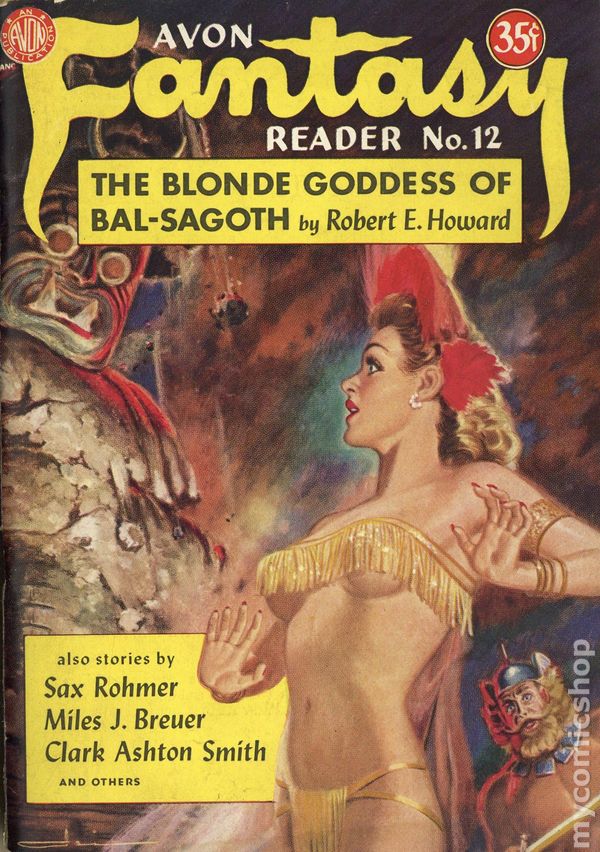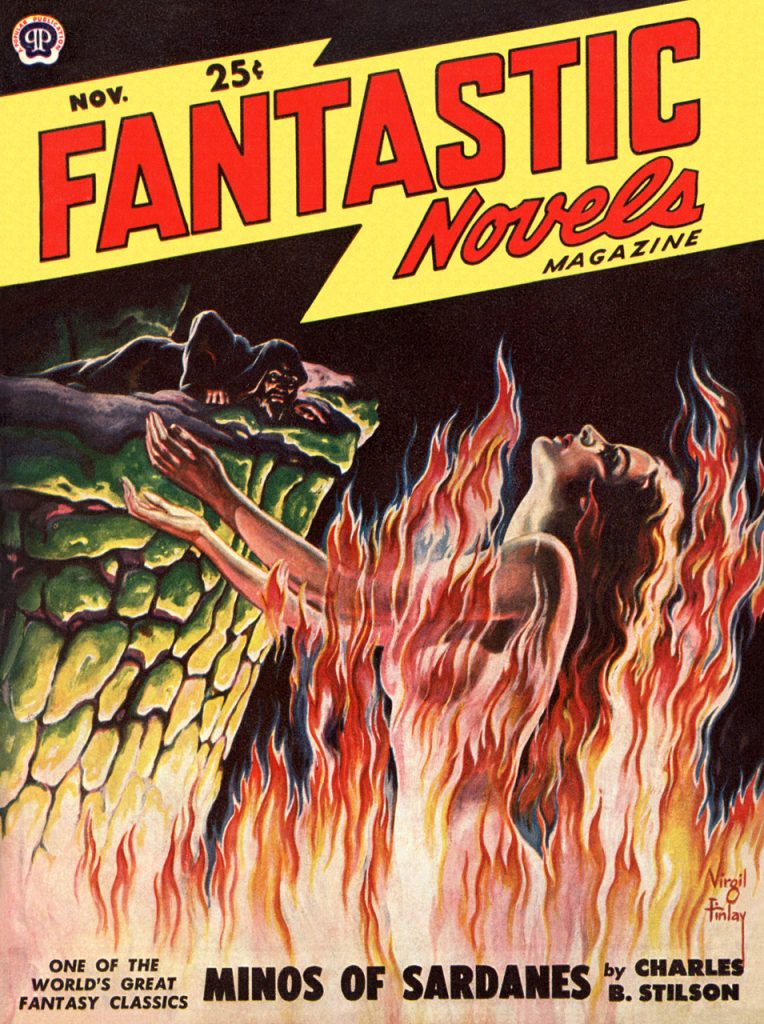SENSOR SWEEP: Old-School Feel, Pink Slime Amorality, Tyrannical Future Societies, and Self-Aware Storytelling
Monday , 15, May 2017 Sensor Sweep 7 Comments Appendix N (Rampant Games) Breaking the Old-School Fantasy Game Code — “A lot of talk lately has been about how people have suddenly rediscovered pulp because of his book (or the original blog posts), which is something I’ll talk about later this week. But from a game-design perspective, as a guy trying to infuse a game with that old-school flavor that I feel has been lost over the years, this has been a gold mine. It explains so much, and I think it’s helped me ‘crack the code’ and understand the source of some of this ‘old-school feel’ I’ve struggled to define – drawing inspiration from the same sources.”
Appendix N (Rampant Games) Breaking the Old-School Fantasy Game Code — “A lot of talk lately has been about how people have suddenly rediscovered pulp because of his book (or the original blog posts), which is something I’ll talk about later this week. But from a game-design perspective, as a guy trying to infuse a game with that old-school flavor that I feel has been lost over the years, this has been a gold mine. It explains so much, and I think it’s helped me ‘crack the code’ and understand the source of some of this ‘old-school feel’ I’ve struggled to define – drawing inspiration from the same sources.”
Publishing (Kairos) Fake Ebook News — “There you have it: another stake driven through the heart of this undead, and patently false, meme. Of course, we can be sure that the Big Five publishers will dig up the fake news of eBooks’ decline right back up again–at least until they’re out of business. For now and the foreseeable future, indie and small publishers are where the growth is at.”
Pulp Revolution (SuperversiveSF) Why Comics Stopped Trying — “He’s correct that many high priests in the entertainment industry death cult have cast off objective morals to avoid accusations of having committed the last remaining sin: hypocrisy. What they miss, due to a (likely purposeful) corruption of language, is that hypocrisy is not striving to hit the mark and missing. It’s arbitrarily setting one target for yourself and a different target for others.”
Appendix N (Injustice Gamer) Injustice Book Review: Appendix N by Jeffro Johnson — “From my readings, the greatest blow this book delivers is to the separation of the genres of science fiction and fantasy. It also puts the lie to much of what is considered ‘Hard SF’. During the era of the Pulps, there was no division, nor was there seen to be a need for such. The fact is, that most of the science of ANY era will be outdated at some point. Acknowledge that, and the marketing, like most marketing, is easily visible as false.”
D&D (Bat in the Attic) Thoughts on Tabletop Roleplaying – Why? — “After reading Matt Finch’s Old School Primer a bunch of things came together in my head that didn’t happen when I first used AD&D. I saw how I could do with OD&D everything I was doing with other RPGs like GURPS but without the overhead of the more detailed mechanics. I still enjoy playing those RPGs but OD&D worked out as the better choice for the time I had.”
Roleplaying Games (SuperversiveSF) The Superversive in Tabletop RPGs: Why Is It So Rare? — “The non-stop mockery of virtue, of the pursuit of a moral or ethical standard, and the misunderstanding (often willfully so) of what ‘hypocrisy’ means all contribute to this subversion of the ostensible claim to ‘heroic adventure’ (which they also misunderstand). You see this in the long-form when the rules for games in strongly moral settings, such as Star Wars, keep getting watered down to allow for that demoralization to feed upon itself at the table. You see this in the creep of their Pink Slime amorality into their rules and settings, and the pushing of clearly subversive messages (i.e. yet more virtue-signalling) into every part of their business output- product and service alike.”
Pulp Revolution (Might Thor Jr.) Spotlight: Cirsova: Heroic Fantasy and Science Fiction Magazine — “What got me into fantasy in the first place? The answer to that was Sword and Sorcery and other pulpy spec. fic. goodness. I love REH, ERB, Lieber, Lovecraft, Moorcock, Wagner, and Clark Ashton Smith. So sure I can get out all my old copies of these authors, and I did. But I began to wonder, is anyone still writing this type of fiction? Where are the authors writing it and where do I find them? Surely this form of speculative fiction is not dead?”
Appendix N (RMCW Reviews) Stealing from the Best: Dr. Fate and The Ship of Ishtar — “In 1940, DC comics published More Fun Comics #55, in which a blue-clad archaeologist named Kent Nelson, who is a champion of Nabu (revealed in issue 67) equipped with his magical items, rescues an initially red haired woman named Inza (who would eventually become his wife) from an ancient sorcerer. That can’t be coincidence.”
 The Campbellian Heresy (Just The Caffeine Talking) Retro-Review: Famous Science-Fiction Stories (Part 4 and Conclusion) — “The editors were putting together an all-star anthology — so why waste space on tomfoolery like ‘Time Travel Happens!’ or filler like ‘Within the Pyramid’ when they could have included C.L. Moore’s ‘Shambleau’ or Murray Leinster’s ‘First Contact’? I guess it’s not too surprising that a collection published a year after the end of the most devastating conflict in human history would have a somewhat grim tone. Six of the stories are about the end of life and/or civilization, and another four concern either tyrannical future societies or attempts to impose tyranny….”
The Campbellian Heresy (Just The Caffeine Talking) Retro-Review: Famous Science-Fiction Stories (Part 4 and Conclusion) — “The editors were putting together an all-star anthology — so why waste space on tomfoolery like ‘Time Travel Happens!’ or filler like ‘Within the Pyramid’ when they could have included C.L. Moore’s ‘Shambleau’ or Murray Leinster’s ‘First Contact’? I guess it’s not too surprising that a collection published a year after the end of the most devastating conflict in human history would have a somewhat grim tone. Six of the stories are about the end of life and/or civilization, and another four concern either tyrannical future societies or attempts to impose tyranny….”
Appendix N (Into the Night) Appendix N Challange: The People of the Crater by Andre Norton — “The first thing that hits you after you put the book down is just how tightly it’s plotted. You’d have to be an idiot to claim that the pulp writers bloated their works, the reality is just the opposite. There isn’t a wasted word paragraph or scene in the whole story and it clips along. It read like a blend of Merritt and Burroughs but with enough of an individual voice that it never felt like a pastiche or homage.”
Comics (Wasteland and Sky) Aware of the Dark — “Self-aware storytelling doesn’t believe in anything. It doesn’t even believe in itself. It doesn’t believe in the audience, constantly winking to them and assuring them that they are too smart for this silly story. It doesn’t believe in heroes by constantly undermining their struggles. It doesn’t believe in hope since nothing that occurs matters as we are reliably informed by the characters themselves. It is, as Razorfist stated, aimless, trite, and unmotivated, storytelling. It exists to stroke egos and nothing else.”
Movies (The Frisky Pagan) Asimov’s Adventure editorials IV: Hollywood, movies, and pew-pew sci-fi. — “We are not nobler than the people in Hollywood; if we were exposed to their pressures, we might do just as they do. But we are not in Hollywood, we are here; and so we need only please one thousandth the size of audience that they do. We like to think that our thousandth part of the audience happens to be the best thousandth. It is an audience that can read, that likes its adventure with good writing stirred in, that has a respect for science even when it doesn’t have a professional understanding of it.”
Appendix N (PC Bushi) The End of the Dying Earth — “In all honesty I found the Rhialto tales a little anticlimactic as an end to the Dying Earth. The first story, ‘The Murthe,’ was interesting if only for the concept of a magical battle of the sexes and the comical tactic of changing men into women (not to mention ‘ensqualm’ is a fun word). I wanted to like ‘Fader’s Waft’ more than I did. Vance’s approach – a sort of magical whodunnit – was different and entertaining, but the length and pace put me off a bit. The ending didn’t really feel like a satisfying payoff. The last story, ‘Morreion,’ wasn’t bad. Many D&D players will no doubt be familiar with IOUN stones. Well, if you were ever wondering about the origin of such things, look no further!”
Books (Vintage Novels) Pinocchio by Carlo Collodi — “These religious aspects of the story are certainly intentional. Gepetto, Pinocchio’s father figure, is also his Maker. And the insistent description of the saintly Fairy’s blue hair seems, even to a Protestant growing up in a secular culture like me, a fairly overt reference to the blue scarf associated with the Virgin Mary in traditional religious iconography. But I was disappointed that in the end, Pinocchio wins his goal simply by learning to turn over a new leaf, empowered by his own innate goodness.”
Traveller (Tales to Astound) About those Ship’s Computers… — “The computer system in Traveller starships handle many functions, but one of the most important is handling the Generate program or running the Navigation programs that allow the ship to track and navigate from star system to star system and arrive close enough in a system to the system starport that the ship can dock before running out of life support but not so close that the ship is destroyed by a world’s gravity well when coming out of jump space. The storage of the programs of data for these programs alone must be monstrous. If the computer system is damaged and there is no facility to repair it, there is no way to leave a system. A crew and passengers might not be going home for a long while… if at all.”
 Meanwhile… (Benjamin Cheah) Book Unreview: The Gatekeepers by Nuraliah Norasid — “Barani believes that Ria petrified the government representatives because it was her way of protesting against the authorities. That may be so, but why petrify everybody else in the village? It is not revenge against oppression; they have not been oppressed. It is not self-defence; nobody was attacking them at that time. What Ria really did was to vent her frustrations against a faraway government on innocent villagers near her. In other words: she threw a temper tantrum. And in so doing, became a monster.”
Meanwhile… (Benjamin Cheah) Book Unreview: The Gatekeepers by Nuraliah Norasid — “Barani believes that Ria petrified the government representatives because it was her way of protesting against the authorities. That may be so, but why petrify everybody else in the village? It is not revenge against oppression; they have not been oppressed. It is not self-defence; nobody was attacking them at that time. What Ria really did was to vent her frustrations against a faraway government on innocent villagers near her. In other words: she threw a temper tantrum. And in so doing, became a monster.”
Appendix N (Into the Night) Appendix N Challange: A Martian Odyssey by Stanley Weinbaum — “Everything about A Martian Odyssey is good. A solid plot, a likeable hero with an interesting companion. Clear motivations and vivid descriptions. The dialogue clips along and although Weinbaum indulges a penchant for accents it’s not so frequent that it’s annoying. Where Weinbaum stands out is in the pure imagination stakes. There are aliens on Mars and they are exactly that. Alien. They do not think like us, they do not act like us and they are not motivated as we are. They can be described, but they cannot be understood.”
Man, Dean is trucking through AppN!
You always find the very best magazine cover art to feature. I didn’t fully appreciate this until recently. There were some real duds, too.
Alright! Two mentions. Thanks, Jeffro!
Thanks for the link!
My posts at SuperversiveSF really are making a mark.
Thanks for the mention!
Good post from Kalvaitis on the Merritt/Gar Fox/Dr. Fate connection. Something similar occurred to me when I first realized Fox was a huge Merritt fan, but I never did anything with the idea. Gardner Fox is THE vector for the influence of Merritt on the comics, though Julius Schwartz is also on record as being a fan of ol’ Abe.